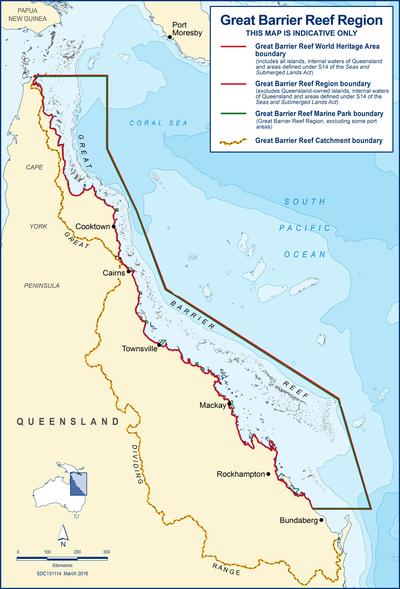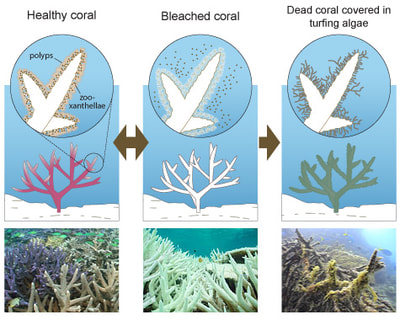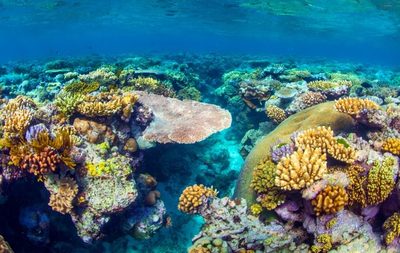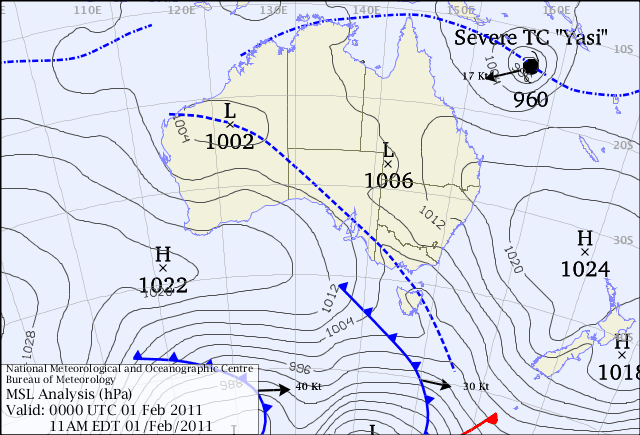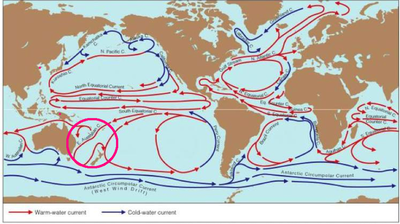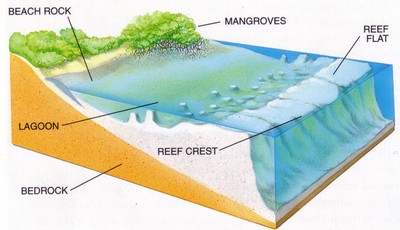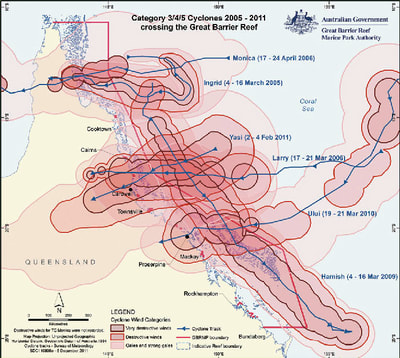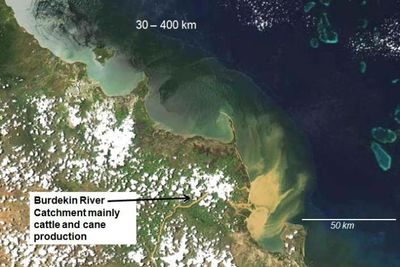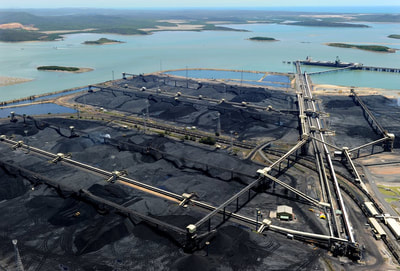Spatial Patterns and Dimensions
Location
The Great Barrier Reef is located along the North East coast of Australia between its northern extent of Bramble Cay (9°08’S 143°52’E) in Torres Strait to Lady Elliot Island (24°06’S 152°42’E) in the South. It is entirely contained in the Coral Sea and affected by the current flowing from the Pacific Ocean.
The Great Barrier Reef is located along the North East coast of Australia between its northern extent of Bramble Cay (9°08’S 143°52’E) in Torres Strait to Lady Elliot Island (24°06’S 152°42’E) in the South. It is entirely contained in the Coral Sea and affected by the current flowing from the Pacific Ocean.
Altitude
The reef is an aquatic and marine ecosystem and cannot gain a higher altitude than the low tide limit. However, as the coral require sunlight it’s growth is limited to a depth of 150m, although 80% of corals grow in shallow waters.
The reef is an aquatic and marine ecosystem and cannot gain a higher altitude than the low tide limit. However, as the coral require sunlight it’s growth is limited to a depth of 150m, although 80% of corals grow in shallow waters.
Size
The Great Barrier Reef has a total area of approximately 344,400km2.
The Great Barrier Reef has a total area of approximately 344,400km2.
Shape
The reef forms a long narrow band around 2,300km long from North to South, but only ever reaching up to 300km off shore.
The Great Barrier Reef is actually not a single feature. It is composed of over 2,900 individual reefs and over 900 islands.
The reef forms a long narrow band around 2,300km long from North to South, but only ever reaching up to 300km off shore.
The Great Barrier Reef is actually not a single feature. It is composed of over 2,900 individual reefs and over 900 islands.
Continuity
The current reef structure is around 20,000 thousand years old. However, the geology of the reef indicates corals have grown in this location for much longer. GBRMPA believes corals have been present for 600,000 years.
The current reef structure is around 20,000 thousand years old. However, the geology of the reef indicates corals have grown in this location for much longer. GBRMPA believes corals have been present for 600,000 years.
Biophysical Interactions
Like any ecosystem, the Great Barrier Reef has developed from a range of biophysical interactions that are unique to a place. It is the requirements of the coral polyp that have been the most significant contribution to the development of the reef.
The coral polyp is a keystone species. All other life on the reef relies, directly or indirectly on the limestone structures build as an exoskeleton by the various species of coral polyps.
The coral polyp is a keystone species. All other life on the reef relies, directly or indirectly on the limestone structures build as an exoskeleton by the various species of coral polyps.
Geomorphic and hydrologic processes
The East Australia Current
Reef Geomorphology
The East Australia Current
Reef Geomorphology
|
Biogeographic processes
Invasion and succession Biological adaptations and modifications Coral Spawning and resilience |
|
Adjustments in response to natural stress
The Nature and Rate of Change
Recall that changes in ecosystems can be either gradual or catastrophic.
Rapid changes
Pollution spills
Coral bleaching events
Pollution spills
Coral bleaching events
Medium term changes
Increase in tourism pressures
Introduced species
Commercial fishing
Increase in tourism pressures
Introduced species
Commercial fishing
Longer Term changes
Urban Development
Climate Change
Urban Development
Climate Change
|
|
|
Human Impacts (both positive and negative)
Coal Mining
Commercial Fishing
Tourism Operations
Tropical Agriculture
Reef Management Programmes
IPCC and International Climate Change Agreements
Traditional and Contemporary Management Practices
Traditional Management Practices
There are many indigenous groups who lived on lands adjacent to the Great Barrier Reef.
Some of the general practices used in managing the reef include:
There are many indigenous groups who lived on lands adjacent to the Great Barrier Reef.
Some of the general practices used in managing the reef include:
- Taboos
- Hunting seasons
- Nomadic Lifestyles
- Thorough ecological knowledge embedded in ongoing cultural practices (eg Stories, Dances, Songs, etc)
Contemporary Management
The contemporary management of the Great Barrier Reef centres on the unified management of the reef by the Great Barrier Reef Marine Park Authority (G.B.R.M.P.A.), a statutory body operating at the federal level. For over 50 years, GBRMPA has used a zoning policy to manage human impacts on the reef. Currently management efforts focus on building resilience. The Australian Government has recently announced the Reef 2050 plan for long term sustainability.
The Australian Government has also had the Great Barrier Reef inscribed as a World Heritage site.
Unfortunately, agricultural and mining practices that have significant affects on the reef are not managed by a single authority and often have aims that are not aligned with the long term sustainability of the Great Barrier Reef. .
Similarly, although climate change is probably the largest threat to the Great Barrier Reef, this is far beyond the jurisdiction of the authorities responsible for management of the reef.
The contemporary management of the Great Barrier Reef centres on the unified management of the reef by the Great Barrier Reef Marine Park Authority (G.B.R.M.P.A.), a statutory body operating at the federal level. For over 50 years, GBRMPA has used a zoning policy to manage human impacts on the reef. Currently management efforts focus on building resilience. The Australian Government has recently announced the Reef 2050 plan for long term sustainability.
The Australian Government has also had the Great Barrier Reef inscribed as a World Heritage site.
Unfortunately, agricultural and mining practices that have significant affects on the reef are not managed by a single authority and often have aims that are not aligned with the long term sustainability of the Great Barrier Reef. .
Similarly, although climate change is probably the largest threat to the Great Barrier Reef, this is far beyond the jurisdiction of the authorities responsible for management of the reef.
Further Reading
The Conversation - Articles on The Great Barrier Reef
UNESCO World Heritage List - Great Barrier Reef Listing
GBRMPA Website
Australian Government Department of the Environment - Managing and Protecting The Great Barrier Reef
Barclay, P. (2018) Building the resilience of the reef, ABC RN Big Ideas, available at: http://www.abc.net.au/radionational/programs/bigideas/building-the-resilience-of-the-reef/10098660
The Conversation - Articles on The Great Barrier Reef
UNESCO World Heritage List - Great Barrier Reef Listing
GBRMPA Website
Australian Government Department of the Environment - Managing and Protecting The Great Barrier Reef
Barclay, P. (2018) Building the resilience of the reef, ABC RN Big Ideas, available at: http://www.abc.net.au/radionational/programs/bigideas/building-the-resilience-of-the-reef/10098660
